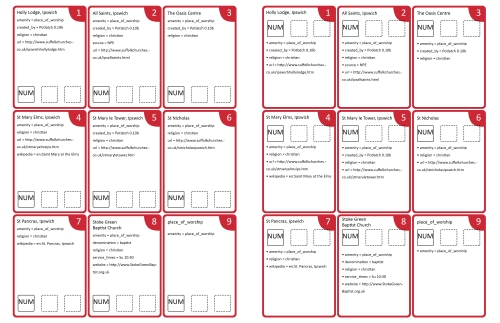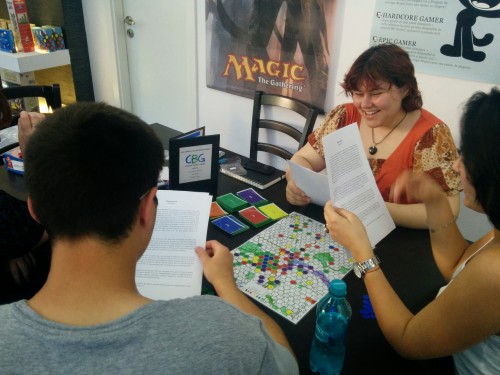One of the final results of my dissertation was a game that had different rules based on two different target audiences. In my dissertation proposal, I stated:
I want to be marked on my ability to create a game and how fun it is. Fun, being a vast concept, cannot be rated easily, so I would like to focus on engaging diverse target audiences and create one game which appeals to a minimum of two different target audiences. My dissertation will focus on implementing a simple set of mechanics and then creating different incentive systems for different target audiences. As such, I would like to be marked on the engagement ability of the game for my chosen audiences.
I believe that the game and challenges (or minigames, call them what you will) that I have added to the game fit well with most target audiences and most player types, according to Bartle’s types. The Killers will find pleasure in stalking players as they are juuust about to finish a PoI and claim it from beneath their noses, the Achievers will go for getting as many points as possible and carefully scrutinizing the rulesheet to see how to best maximize their points from all the different combinations of tags and PoIs that can be found in their mission card. The Socializers will laugh as they try the challenges and will prefer to go for the social ones such as NUM, RPS and THR, maybe even HID, and then they will make a jest when they lose or win at one of those, while the Explorers will be happy to explore as much of the town as they can, sometimes even without claiming PoIs, simply scouting as many as possible.
But, as fun as I think I made the game, there are 8 billion people out there, and some of them won’t be served by the mechanics that I’ve created and the dynamics won’t appear as I envisioned them. As such, I decided to create a few different rules, or variants as I call them, of the game, that I hope will help enlarge the number of different people that will like to play the game which, by the way, I’ve decided to call “Mapping Party”.
These are the three variations that emerged from discussions with my playtesters:
Extra challenge – Word chain
WOR – Word chain. In this challenge, the player needs to choose a word and say it. Then they choose another player to play with. That player needs to continue the word chain by saying a word that starts with the last two letters of the first word (for example, education would be a valid reply to the word red). If 11 words are chained together or the scouting player manages to „lock out” the other player, then the tag is unlocked. A player is „locked out” when they can’t come up with a reply to a word (for example, „blue” is a word that locks the other player out – there are no English words that start with „ue”). Generally, proper nouns such as person names are not accepted as valid replied.
Extra rule – Stealing
Once every turn, instead of moving or scouting a PoI, a player can choose to try and steal a PoI that another player is currently scouting (claimed PoIs cannot be stolen). To steal a PoI, the player has to win a number of challenges equal to the number of scouted tags on the PoI that they are trying to steal (number of scouted tags = number of unlocked tags + 1). The player that is trying to steal a PoI can choose their own 3 distinct challenges to sequencially solve from the list of challenges. If the player that is trying to steal a PoI card fails a challenge, then they end their turn. Each stealing attempt must start a PoI card from the first tag, indifferent to where they failed the challenge the previous time. Only one PoI card can be stolen at a time, and a player cannot steal from the same player two turns in a row.
Extra rule – Returning to start
At the beginning of their turn, a player can choose to skip their turn, and return to the starting hex (the black hex). The player needs to return the card they were currently scouting to the pool of unclaimed PoIs.
I’ve added the extra challenge for Socializers and Achievers. The Socializers will want to see how other players think and will jump on any extra opportunity to have verbal interaction with other players. The Achievers will want to prove that they have the best control over the language that the players speak. Also, the WOR challenge suits a game of two players better than the NUM challenge, where there’s no reason to pick the number 1 if there are only two players. This is also the result of my playtesters loving the concept of challenges and wanting more of them. The WOR challenge can be exchanged with any other challenge.
I’ve added the extra rule especially for Killers. I’ve recently played a game called Carpe Astra which allows you to choose between Slander and Network during your turn to gain resources and influence, with Slander being the option of taking influence from another player and transferring it to yourself. I’ve played with quite a few Killers in that game, and noticed that ALL of them almost always if not always went for Slander, because they loved to take stuff from other players in order to further their advance. I decided that this stealing mechanic would suit a target audience such as teenage boys really well, and I’ve had positive feedback on it from the Killers that I’ve played with.
Lastly, one of the Socializers that I’ve played with mentioned that she would’ve liked to be able to return to the black starting hex and having more mobility on the map, even if that required her to give up a PoI she was currently scouting. I realized that this would indeed help her and would allow for more strategy in completing the missions, so I added it to the variations.
There you have it, three extra rules which I believe will help different target audiences feel better about the game and enjoy it more.
Two target audiences, as we define them when making video-game pitches, that I would see could play this game and have fun, would be teenage boys, between 13 and 16 years old, and women between 20 and 30 years old, who have a focus on their professional lives. The boys fit in the Achiever and Killer archetypes, so they would probably go for the Stealing mechanic, while I would see the women with that social profile as Socializers, but also Achievers, so they would like the WOR challenge and the returning to start mechanic.
That being said, I would like to mention again that I’ve playtested this game with people of various ages, cultures and personalities, from 8 year-old kids to game design tutors and marketing professionals and received more and more positive feedback from them as I iterated onward. I believe that at the moment the game is in a state where I can say that it definitely answers the three criteria I discussed about with Rob a while back:
- I want people to take notice of what’s laid on the map.
By adding the PoIs’ real location on the map as it’s added to OpenStreetMap, I’ve made sure of this. McGinty’s in Ipswich, for example, is almost where McGinty’s really is (small error due to the coloured hexagon, but it should be within a 100m radius). That bank that’s in front of your house, close to Aldi’s in Ipswich is definitely there as well. People will know what’s on the map and know that features are where they are in real life as well, should they want to further explore the town.
- I want people to know which Points of Interest they have searched.
By having the players unlock the tags one at a time, I make sure that each PoI they scout is memorable. This will allow people to remember information about the PoIs that they are scouting and also notice errors or missing information in the OSM database with PoIs they have information about.
- I want people to know how to assign characteristics to things.
That’s why I’ve added all the tags to each amenity, as opposed to earlier iterations where you made guesses about which tags went where. Like this, people will familiarize themselves with common tags (addr:*, postcode, opening_times etc.) and will begin their OSM journey with some previous knowledge, should they want to become a contributor.
Chris F.












